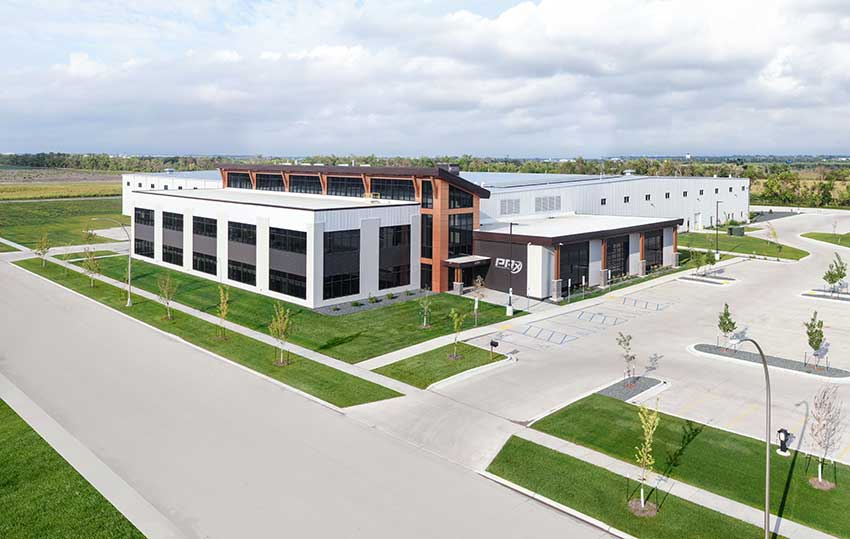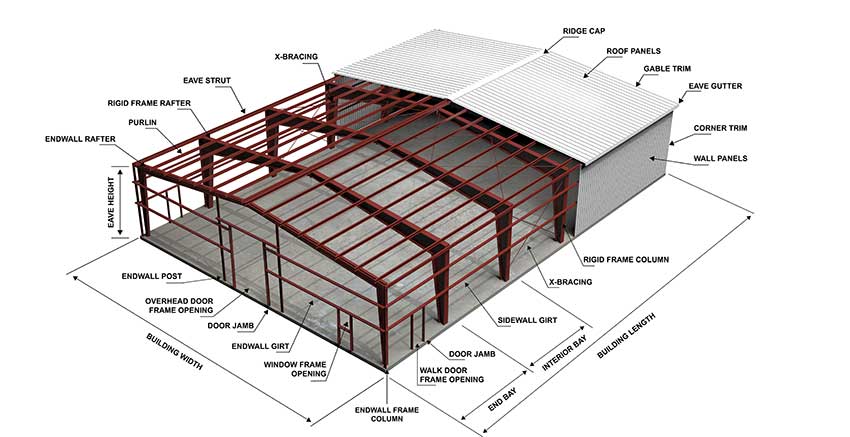Evaluating Metal Building Systems Using COMcheck™
Learning Objectives:
- Identify and recognize the basic characteristics and components of metal building systems that meet or exceed requirements for energy codes.
- Investigate the design options allowed in the current energy codes including the IECC and ASHRAE 90.1
- Use COMcheckTM software as a well-known tool to demonstrate energy code compliance in metal building systems.
- Eliminate confusion over misperceptions or questions related to metal building systems and energy performance, particularly when COMcheckTM is used.
Credits:
This course is approved as a Structured Course
This course can be self-reported to the AANB, as per their CE Guidelines
Approved for structured learning
Approved for Core Learning
This course can be self-reported to the NLAA
Course may qualify for Learning Hours with NWTAA
Course eligible for OAA Learning Hours
This course is approved as a core course
This course can be self-reported for Learning Units to the Architectural Institute of British Columbia
Metal building systems typically account for about one-quarter of all the low-rise commercial construction in the United States each year. These systems have evolved in the past few decades and are now fully capable of meeting and exceeding energy code requirements in all climate zones of the United States. However, there is often some confusion about the make-up of the wall and roof assemblies, what the options are, and how they impact energy code compliance. COMcheck™ is a widely used software tool to demonstrate energy code compliance that is fully customizable to suit different project requirements, including metal buildings. The software is available for free from the U.S. Department of Energy and includes all of the options in the codes, relying on the building designer to input the appropriate information. It then calculates the overall energy performance of the building envelope to determine if the design meets the code requirements or not by using the envelope trade-off method. This course looks specifically at the benefits of using COMcheck™ for metal building system designs and addresses some of the most common questions and uncertainties that architects may have related to metal buildings and energy performance.

Photo courtesy of Metal Building Manufacturers Association
Metal building systems can be readily designed to meet energy codes, as is easily proven by using COMcheckTM software.
METAL BUILDING SYSTEMS OVERVIEW
Metal building systems are offered by manufacturers who generally provide a complete package of products and services for a custom-engineered structure, which can take one of two forms. First, they can be the single source for a total metal building system, which is a complete package of products, and services for both the structural system and the primary building envelope components, such as exterior wall and roof assemblies. That means the total building structure and envelope are designed, specified, and assembled using components that are custom fabricated according to the design prepared by the building’s architect of record. The primary steel structure consists of main columns, beams, or engineered rigid frames while the secondary steel structural components include girts, purlins, etc. for rigidity and attachment of wall and roof systems. The envelope typically consists of metal wall systems (metal panels, insulated or not) plus metal roof systems or panels that are designed to meet project specifications.
The second form of a metal building system is a combination or a hybrid building that can be designed and built by incorporating only some of the systems from a metal building manufacturer such as the primary and secondary structural portion. In this case, the wall and roof envelope assemblies are constructed from traditional building materials and methods such as concrete, masonry, wood, glazing systems, etc. As such, the finished building can look, feel, and perform like any traditional building. For existing buildings, it is possible to retrofit only metal siding and/or metal roofing on top of or in place of existing wall and roof assemblies. Some manufacturers may also provide supporting products and materials such as insulation, fenestration, roof curbs, and doors for use in either a total metal building system or a hybrid one.
The use of metal building systems has become so common that the 2024 International Building Code (IBC) now recognizes them with this definition: “An integrated set of fabricated components and assemblies that form a complete or partial building shell that is designed by the manufacturer. This system typically includes, but is not limited to, primary framing composed of built-up structural steel members, secondary members that are cold-formed steel or open-web steel joists, a metal panel roof system, and exterior wall cladding. The system is manufactured in a manner that permits plant or field inspection prior to assembly or erection.”
Once the specified package is fabricated to order, it is shipped to the project location for on-site erection and installation, typically by an independent erector/installer or general contractor. With this working model as a basis, it is easy to see that it is more streamlined and usually more cost-efficient to design and construct a single-source metal building compared to conventional, multiparty construction.

Photo courtesy of Metal Building Manufacturers Association
The basic elements of a total metal building system include the primary and secondary steel structure plus the basic envelope including metal roofing, metal siding, and, sometimes, the insulation.
Significant Attributes
Metal building systems are a distinct type of construction for low-rise buildings with a number of appealing attributes. The structural system offers complete design flexibility including the option for longer clear spans, often using built-up tapered-web members, compared to traditional steel framing (i.e., hot-rolled steel beams, columns, etc.) thus creating very open spaces. The structure and the rest of the system designs are optimized to provide efficient use of materials while minimizing waste. The process of working with a metal building manufacturer typically allows for a faster design process, streamlined fabrication, and a shortened construction process when compared to conventional construction. All of these traits help keep the cost of metal buildings very competitive and quite favorable in many instances.
Typical Metal Building Wall Systems
One thing that distinguishes metal building systems is the variety of wall systems that are possible. Since the structural steel frame bears the load, there are options for architectural or industrial metal walls, brick, glass, wood, masonry, EIFS, tilt-up, insulated metal wall panels, or other materials.
When the wall assemblies are provided by a metal building manufacturer, they typically come in a form aligned with one of the ASHRAE 90.1 wall assembly types defined in the Normative Appendix, Section A3.2.2. Those assembly types include:
- Single-Layer Compressed, where a single layer of insulation is compressed between the girts and metal panels. Special cases can include thick or multiple layers of insulation, but care must be taken to avoid oil canning of the metal panels.
- Single-Layer in Cavity, where a single layer of insulation is installed in the cavity between the girts that is not compressed by the metal panels. This can be a faced layer of insulation or can be unfaced insulation with a separate facing installed inside the girts. Thermal spacer blocks or thermal break strips may be required between the girts and metal panels if required in Table A3.2.3 or the proprietary assembly test or modeling report.
- Double-Layer, where one layer of insulation is installed in the cavity between the girts and a second layer is installed between the girts and metal panels. Thermal spacer blocks or thermal break strips may be required between the girts and metal panels if required in Table A3.2.3 or the proprietary assembly test or modeling report.
Other assemblies like continuous insulation or proprietary systems may also be used. Most of these wall assemblies are compatible with using gypsum board or other common interior wall finishes.
Another option for walls is to use a fabricated insulated metal panel (IMP) which incorporates rigid insulation sandwiched between an inner and outer metal facing to form a composite panel. This type of product is pre-insulated and has appeal in many building applications since both the exterior and interior surfaces are pre-finished and can be detailed to meet air and vapor transmission requirements. It should be noted, however, that IMPs do not meet the definition of “continuous insulation,” since the panel edges intrude within the foam sheathing insulation. However, the U-factor of an IMP assembly may be adequate to negate the need for continuous insulation. Furthermore, IMP designs can provide fairly good insulation values per inch of thickness when used properly.
Typical Metal Building Roof Systems
It is most common for a metal building system to use metal roofing. This is in part because they allow for a low roof slope (less than 2:12) and external drainage (rather than interior drains) which coordinates well with the structural system. It is also quite desirable because of the proven longevity of standing seam metal roofing which is often rated for 50 years or more. Underneath the metal roof panels, insulation can be handled in a manner similar to walls. When the roof assemblies are provided by a metal building manufacturer, they typically come in a form aligned with one of the ASHRAE 90.1 roof assembly types defined in the Normative Appendix, Section A2.3.2. Those assembly types include:
- Single-Layer [Compressed], where a single layer of faced insulation is compressed between the purlins and metal roof panels. Special cases can include thick or multiple layers of insulation, but care must be taken to avoid oil canning of the metal panels. A thermal spacer block may be required between the purlins and metal roof panels.
- Double-Layer, where faced insulation is draped over and perpendicular to the purlins, and a second layer of unfaced insulation is installed above the first layer of insulation and parallel to the purlins. A thermal spacer block may be required between the purlins and metal roof panels. This may commonly be referred to as a Sag-N-Bag system.
- Liner System (LS), where one layer of uncompressed, unfaced insulation is installed in the cavity between the purlins, and a second layer of unfaced insulation is installed and compressed between the purlins and metal roof panels. A vapor retarding fabric liner is attached to and supported below the purlins. Thermal spacer blocks may be required between the purlins and metal roof panels if required in Table A2.3.3 or the proprietary assembly test or modeling report.


















